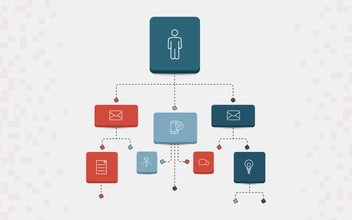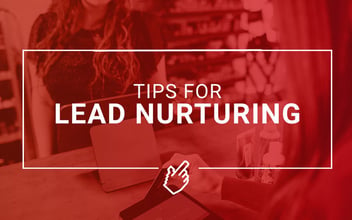Email marketing. You either love it or you hate it. Regardless, in a world where we digest the majority of our content online, it’s important that you do it right. We’ve all seen those anxiety-inducing memes, where someone forgot to add the personalization token for “Hi [FIRST NAME HERE].” Hey, it happens. But here are a few useful tips and tricks to help you avoid becoming the center of the next viral email marketing fail.
Does Email Marketing Still Work?
Did you know that the first marketing email was sent in 1978? Gary Thuerk, a marketing manager at Digital Equipment Corp sent created the campaign, which led to $13 million worth of sales for DEC machines. Talk about a successful launch for the first mass email campaign!
For what was the most innovative form of marketing at the time, technology has grown and evolved for how marketers communicate with our audiences. Now we have more options through media such as social posts and blogging.
Email, however, has stayed a consistent form of communication to help you reach your ideal audience. In 2019, global email users grew to 3.9 billion, and that number is projected to grow to 4.3 billion by 2023. That’s half of the world’s population. So, while social media and blogging rise in popularity, email still has a seat at the table.
Why You Should Use Email Marketing in HubSpot
You’ve determined that you’re ready to incorporate email campaigns into your marketing strategy, but where should you begin? First, you need an email builder tool that will create and send your emails, like HubSpot.
Through HubSpot, you’ll be able to personalize your messaging, create segmented lists, schedule email sends and optimize future content based on previous results. The ability to optimize your emailing is a huge advantage. 269 billion emails are sent everyday, so you want to ensure all the hard work you’re putting into your emails is actually seeing results.
How To Create & Send Emails in HubSpot
This is where the fun begins. You’re ready to build your emails. Keep in mind that the average customer receives 121 emails per day, so no pressure or anything : )
With a high volume of emails going into inboxes on a daily basis, you need to make sure you’re sending out valuable content that your audience actually wants to learn more about. Here’s how you can make yourself stand out from the crowd.
Personalization Tokens
What’s worse than feeling like a robot is talking to you? Probably feeling like you’re one in 15,000 that received a “personal” email without any mention or details that are relevant to you. Inserting personalization tokens elevates your mass email from just another in the bunch and lets you speak directly to your audience.
Emails with personalized subject lines generate 50% higher open rates compared to those that don’t. So incorporating the recipient’s name, company or even a small detail like their favorite color or birthday can be the detail that sets you apart.
Optimized Design
The design and layout of your email has a significant impact on the success of your email. Having great content and messaging but a terrible design is like giving up in the last mile of a marathon.
If your content isn’t easily digestible and navigable, people just aren’t going to read it. Your design also needs to be optimized for mobile devices, too. Never underestimate how many people are going to read that email on their iPhone. In fact as much as 49% of all emails are opened on mobile devices. HubSpot allows you to easily toggle between a desktop and mobile view of every email you send. That way you can be sure everyone’s getting the same great experience.
Segmented Lists
You always need to think of your audience when sending emails. Your recipients will be more likely to open them if it aligns with their personal or business interests and needs. With active lists in HubSpot, you can create segmented lists based on a wide array of properties, i.e. the contact’s birthday, the company’s industry, where they’re located, etc. This is another way to help you make sure your content is getting in front of the right people.
As always, it’s important to consider Buyer Personas. This will also help shape your messaging and the content you want to share depending on where they are in the Buyer’s Journey.
Here’s a quick example. Let’s say you run an auto parts store. Chances are not everyone in your contact list is going to buy the same category of products. Some may not be ready to buy at all, but are just looking for more information to make the best decision possible. Through segmented lists, you can create subsets of your contacts based on who’s looking for what. For example return customers looking for car parts and potential customers who need a little more information on choosing the tools. Sending out one email to your entire list means it’s just not going to be relevant to everyone. Irrelevant emails lead to more unsubscribes and that leads to a smaller list of potential buyers.
How to Analyze Your Email Marketing Results
You’ve successfully been sending out email after email to your segmented audiences with personalized messaging that are optimized for mobile.
Now it’s time to review the performance of your email sends and analyze where you can improve to receive better results. There are a few key performance indicators (KPIs) that will give you insight on how you’re doing:
- Deliverability Rate: Percentage of emails that are actually being delivered to your recipients’ inboxes
- Open Rate: Percentage of emails that are opened once the email reaches the inbox
- Clickthrough Rate (CTR): Percentage of people who click the links in the email
- Unsubscribes: The number of people who opt out from communication once they receive an email from you
From these measurements, you’re able to decide what you need to test or adjust in order to improve your performance.
If your open rate isn’t as high as where you want it to be, you’re going to want to take a look at your subject lines. If your CTR is low, you may want to revisit what offers you’re sending your audience or the messaging in the body of your email.
As you test and play around more with all aspects of your email marketing strategy, you’ll continually learn more about the behavior, wants and needs of your audience. And that is a powerful tool not only in email but your complete inbound strategy.
There are a few things to remember when you start analyzing and tweaking your emails. First, look for trends over time. If your first email doesn’t perform well, analyze the KPIs above and apply them to your next campaign. It’s a good rule of thumb to only adjust one aspect at a time. That way you’ll know exactly what the problem is. For instance, if your open rate is low, try changing the subject line like I mentioned above—but don’t touch anything else. See if that has more success. If not, it might be time to change something else.
Hi [Contact’s First Name], let ProFromGo help you with your email marketing strategy.
Did that feel a little impersonal? We’d love to get to know you better and help you achieve better results with your email marketing. Just fill out our Contact Us form and we’ll get you headed in the right direction.





